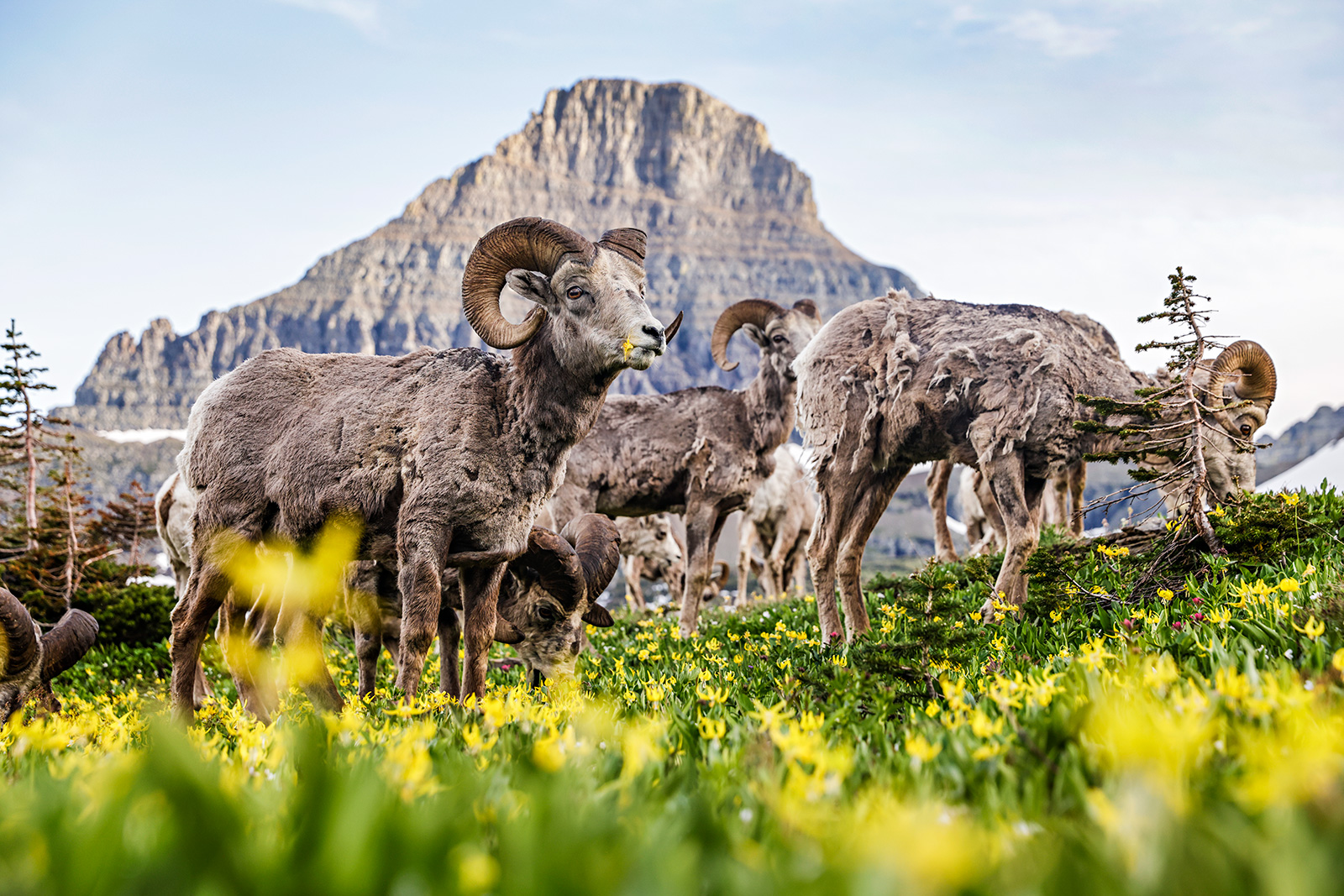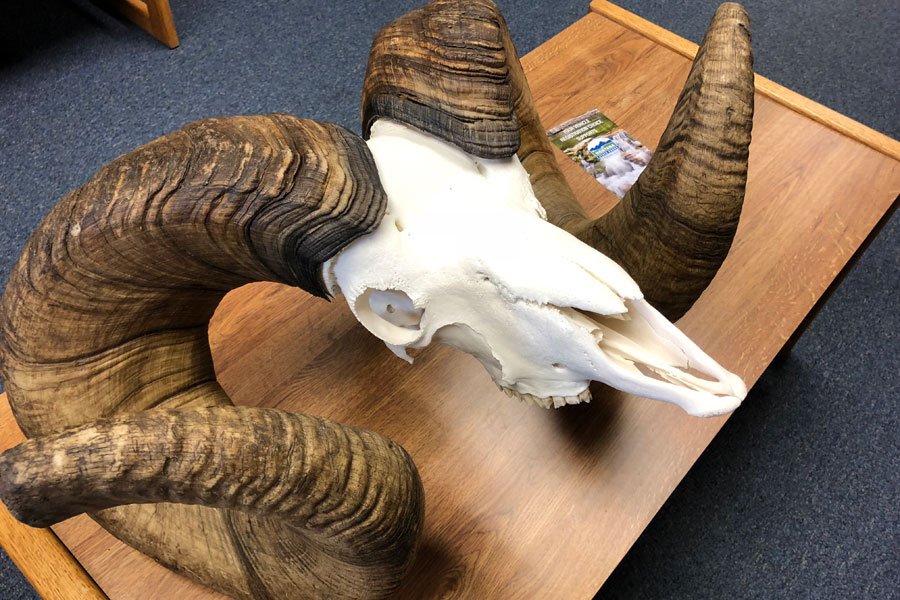
Research Sheds Light on How Glacier Park’s Bighorn Sheep Populations May Transmit Disease
As wild bighorn sheep populations experience die-offs across the West due to respiratory disease, park scientists used a decade of GPS data to discern how Glacier’s sheep might communicate disease in the event of an outbreak
Bighorn sheep and their namesake headwear, which can weigh up to 30 pounds, serve as a prominent symbol of Glacier National Park’s high country, rivaled perhaps only by the mountain goat’s statuesque profile. As such, bighorns are among the most social wildlife species in the park and one of the most frequently viewed by visitors.
Yet despite their eye-catching disposition and impressive characteristics, bighorn sheep face a gamut of evolutionary pressures, including the risk of infectious respiratory disease that is responsible for decimating populations across the West. Although the species is considered secure at global and state scales, local extirpation of herds in Glacier National Park has occurred at various points throughout the park’s history, and in recent decades scientists have wondered how the park’s current populations would respond to a widespread outbreak.
“Respiratory disease has been a concern for decades. The last big outbreak that affected the park’s bighorn sheep was in the 1980s, but it’s always a big concern,” said Tabitha Graves, a U.S. Geological Survey (USGS) scientist based in Glacier National Park and the author of a new study on the implications for disease transmission among the park’s bighorns.
Past research has shown domestic sheep may transfer a bacteria that causes pneumonia in wild sheep if they come into contact. The bacteria Mycoplasma ovipneumoniae can kill bighorn sheep and has also been blamed for stunting an infected herd’s population growth. Despite the reduced risk of Glacier Park bighorns interacting with domestic populations, Graves said that gaining a better understanding of the disease transmission potential among wild populations is no less critical.
“Living in a protected area like Glacier, our sheep aren’t as vulnerable to exposure pathways like you might see outside the park boundary, where wild bighorns can interact with domestic sheep, which can be a main route for introducing disease into a population,” Graves said. “But because we’ve had instances of outbreaks in the past, those pathogens are probably lurking in the background and given the right conditions could flare up.”

Indeed, respiratory disease has been implicated in die-offs of up to 90% of exposed bighorn populations, while the bacteria that causes the illness has also been detected in healthy herds. To that end, understanding what facilitates or impedes movement among wild herds, as well as how bighorns from different social groups interact, is imperative to assessing the implications of disease transmission and identifying management options in the event that a pathogen, such as pneumonia, strikes one or more of the herds living within Glacier and Waterton Lakes National Parks.
Glacier has one of only two large native populations of bighorns in Montana with multiple loosely connected herds. However, their patterns of movement and the environmental characteristics affecting their movement have historically been poorly understood.
Until now.
Using GPS collar and genomic data from nearly 100 bighorns collared by USGS across the eastern side of the park between 2002 and 2012, Graves and her research cohorts identified networks of direct contacts between the park’s bighorn sheep and assessed factors influencing their movements, including the existence of roads, trails, and mineral licks, to create a habitat-use map. They also assessed factors that prompted bighorns to deviate from their normal “hangout” behaviors, including how contact locations and the frequency of associations changed based on extrinsic factors such as mating habits as well as the tendency toward grouping as a means to avoid predation.
“This helped us identify potential areas of disease migration between park herds, which is key to reducing the likelihood that disease will affect more than one bighorn herd,” Graves said.
Because Glacier National Park is home to relatively robust populations of bighorns, it has been identified as a potential source herd for augmenting struggling populations elsewhere in the West. To that end, understanding their habitat use and selection — and how those niche environmental-selection behaviors align with bighorn populations in other regions — could help wildlife managers refine augmentation programs. As social mountain ungulates and habitat specialists, bighorn are a model system to examine social behavior, particularly as extensive research exists on habitat selection and disease ecology.
Although no formal population estimates of bighorn in the park exist, they are considered a species of management concern in Glacier National Park and historical counts suggest that about 500 bighorns comprise its metapopulations.
According to Graves, another consideration for the bighorn study is that much of the landscape is dynamic in Glacier; as snowpack, conifer encroachment, vegetation composition, and forage phenology change, she said, “the when and where of bighorn sheep contacts could likewise change, too.”

For example, the GPS data identified between three and four subpopulations of bighorns in Glacier, with distinct barriers between the animals occupying the St. Mary Lake Valley, the Belly River and Upper Waterton Lake — a region susceptible to wildfires, with climate change models predicting that wildfires will become more frequent and more severe.
“Most recently, the Reynolds wildfire at the St. Mary Lake division has significantly changed the vegetation in this area,” according to Graves. “As such, the divisions that we identified may no longer consist of the same barriers and populations may become more connected. Given the status of this metapopulation as one of only two large metapopulations in Montana, further research could evaluate changes in contact rates, especially across the St. Mary Lake barrier. This could help inform managers of management options should respiratory disease enter one of these subpopulations.”
As Glacier National Park’s natural resources program manager, Mark Biel has a fundamental interest in how wildlife species interact with and across the landscape, as well as how they may be impacted by management decisions, visitor-use patterns and the introduction of disease. Biel, who was a co-author on the bighorn sheep study, said its results could help inform a suite of potential management actions, and help biologists gain a better understanding of travel and migration corridors, backcountry mineral licks, social interactions, habitat preferences, and strategies to avoid predation.
Biel described the latest research was a wake-up call to the potential for population connectivity as a consequence of wildfire and climate change.
“The fires kind of opened our eyes to that connectivity question,” Biel said. “Given climate change and the increasing intensity of fires on the landscape, it also makes us question whether certain food and forage sources are going to grow back. Is it going to be a similar population of plants or will it be different? How will that affect our bighorn sheep habitat? These are all questions that this latest research helps us address.”
Kurt Alt, a retired biologist for Montana Fish, Wildlife and Parks (FWP) and the current conservation director for the Wild Sheep Foundation, said understanding the interplay among wild bighorn sheep populations is as important to the species’ conservation as understanding contacts between wild and domestic sheep populations.
As FWP embarks on a five-year, $8 million project to evaluate herd genetics and disease, as well as refine pathogen profiles and identify the potential for herd augmentations, Alt said research like the Glacier Park study helps take stock of genetic connection and disease transmission potential.
“In my past life we did a good job in spreading pathogens around the state by augmenting struggling populations with individuals from strong populations, i.e., a forced commingling contact between wild and wild,” Alt wrote in an email. “But at the time the profession didn’t have genetic knowledge and current pathogen knowledge including what we believe is the main culprit — Mycoplasma ovipneumoniae. We know better now.”
Both Biel and Graves emphasized the importance of using historic data as the study’s underpinning, as well as the support of the nonprofit Glacier National Park Conservancy to fund the study, which is titled “Bighorn sheep associations: understanding tradeoffs of sociality and implications for disease transmission.”